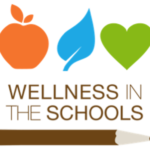May 1, 2020
Our FoodPrints Anywhere theme for the month of May is Plant Science. Today, we are starting with soil because soil is the foundation for all our plants and food. In this edition, we help you make discoveries about soil, learn how to make broth for soup from leftover vegetable scraps, and get creative with homemade animal puppets.

Vegetable Broth from Scratch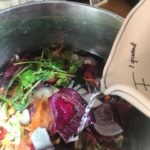
In the garden, soil is the base for healthy plant growth, and in the kitchen, vegetable broth is the base for many nutritious and tasty soups. This week, learn How to Make Broth from Scratch, perfect to use in your Scrumptious Soup Bowls!
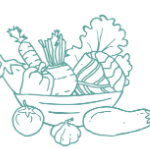 Activity for Kids in the Kitchen:
Activity for Kids in the Kitchen:
> Use vegetable scraps to grow a Veggie Forest in your kitchen! All you need are vegetable scraps that have some stems and greens remaining on them (such as the top of a carrot, beet, radish, or turnip), water, and a baking dish. (Similar to making broth, this project provides another fun way to use vegetable scraps before composting them or throwing them away.)
> Check out how to grow a garden using veggie scraps!
WITS BITS
Nutrition & Cooking Resources from our Partner, Wellness in the Schools
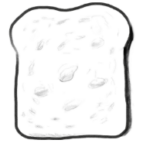 Did you know that microbes are everywhere – in the soil that we use to grow our food AND in our kitchens? They are responsible for making our yogurt thick and creamy, and they are a necessary ingredient in bread! Learn all about microbes and how to make your own Sourdough Starter for Sourdough Bread with Wellness in the Schools.
Did you know that microbes are everywhere – in the soil that we use to grow our food AND in our kitchens? They are responsible for making our yogurt thick and creamy, and they are a necessary ingredient in bread! Learn all about microbes and how to make your own Sourdough Starter for Sourdough Bread with Wellness in the Schools.

What Is Soil?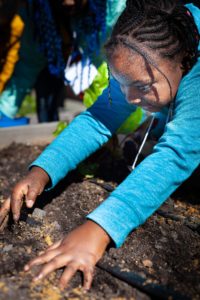
Healthy Soil is a living, breathing organism that is the foundation of all life on Earth. Healthy soil is made up of many different ingredients that soil scientists and farmers study to help them grow healthy plants.
With the help of an adult, collect a small sample of soil from a safe spot outside, and then put on your soil scientist hat and use the activities below to make discoveries about the ingredients in soil:
> Discover Ingredients in Soil (Younger Students): See, touch, and draw the different ingredients that you discover in your soil sample.
> Observe Living & Non-Living Things in Soil (Older Elementary): From rocks and clay to worms, observe & describe the living and non-living things you find in your soil sample.
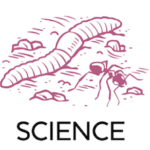
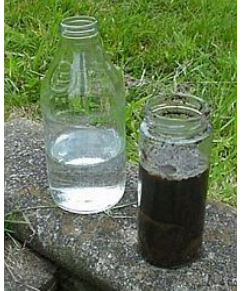 Soil Science
Soil Science
> Soil Separation Experiment: You only need 3 materials: a half cup of soil, one cup of water, and a cup or jar. Combine soil with water in a cup or jar, stir it up, and wait for just a little while. After waiting, you will see that the soil has separated into layers that show the different materials that it is made of. What kind of materials and layers do you think you’ll see?
> Decomposition Guessing Game: See if you can estimate how long different items take to decompose (rot, break down, decay) when buried underground in the soil. From bananas to diapers to Styrofoam, how long does it take for these things (and more!) to decompose? Start guessing now!
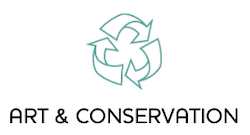
Make Your Own Puppets
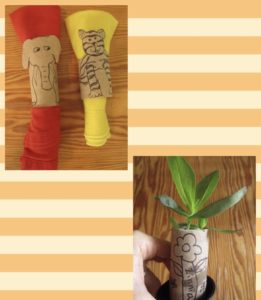
Here is how you can make puppets out of paper towel or toilet paper rolls:
- Find empty toilet paper roll
- Use a marker to draw your favorite animal on it.
- Cut out around the top part of the animal.
- Use your animal as a puppet & have a puppet show
- You can use your puppet as a crayon holder or napkin ring when the puppet show is over
- You can also use scissors to make four small (1-inch), equally spaced cuts on the bottom and fold it to make an animal-themed toilet paper roll planter for growing seeds!
- When you are all done with your paper towel roll puppet, you can recycle or compost it
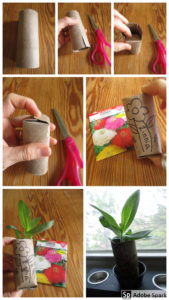
How to turn your puppet into a planter (click photo to enlarge)

Team Up on Food Waste @ Home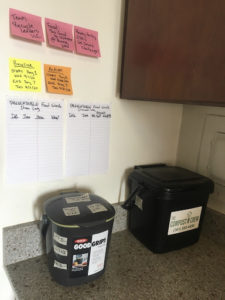
Week 3: Our goal this week is to take action and to start collecting your action data
- Sign up: If you haven’t already, submit your Baseline Report Form!
- Reflect & strategize: Look at your data from week 1, think about why/how food is getting wasted, consider things you could do to reduce food waste in your home, and discuss your ideas with others in your household and/or on your team.
Here are some ideas:
1. Review the Week 3 Cheat Sheet.
2. Watch Beth’s action video.
3. Check out the Share Resources for Teachers Readme.
4. Decide if you want to test any of the specific Tools from the EPA’s Food too Good to Waste Toolkit. - Test your idea: Choose an action and start practicing it this week.
- Gather data: Start collecting data again by the end of the week using the Data Collection sheet and collect data each day for 7 days. (Follow the same procedures as you followed during your Baseline period.)
FoodPrints Anywhere helps build nutrition knowledge, extend science and math education, and helps families cook and eat FoodPrints recipes together at home.

